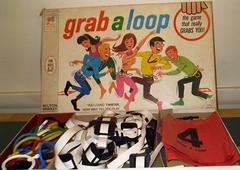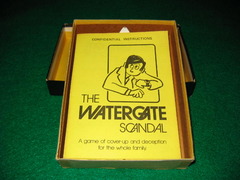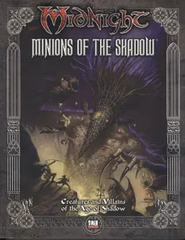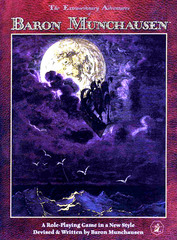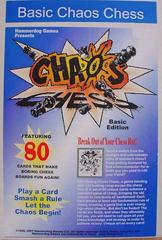
Easter Week, Dublin 1916 1922
-
Description
Who fears to speak of Easter Week?
Who dares its fate deplore?
The red gold flame of Eire's name,
Confronts the world once more.Easter Week is an area/impulse game depicting the Easter Rising in 1916 and the Battle of Dublin in 1922. The Irish Republican Army (IRA) is controlled by the IRA Player and the British Army by the Government (Govt) Player. The National Army is controlled by the IRA in 1916 and the Govt in 1922. In both games the IRA layer seizes strategic buildings across Dublin and must hold them as long as possible despite being outnumbered 10-1. The Govt Player must use his superior forces to retake the city block by block, helped by artillery, bombers, gunboats, tanks and armoured cars. But the IRA is barricaded in thick-walled buildings where a few men can hold up an entire battalion and the centre of Dublin was reduced to rubble before they surrendered. Each side earns victory points during the game and while the IRA Player is unlikely to win the battle he may earn enough VPs to win the game.
Includes:Map (33 x 22 inches)
Countersheet with 280 ½ inch counters
Rules Booklet
In 1912 the Third Home Rule Bill granting devolved government to Ireland was passed by the Liberal Prime Minister Herbert Asquith and John Redmond’s Irish Parliamentary Party. It was opposed by the Conservative and Unionist Party and Sir Edward Carson declared that the Ulster Protestants would never submit to ‘Rome Rule’. 450,000 signed the Ulster Covenant in protest and when this was ignored they took control of Belfast and Eastern Ulster. They raised the Ulster Volunteer Force (UVF) which was armed with 50,000 rifles smuggled in from Germany at Larne. Their cause was strengthened by the ‘Curragh Mutiny’ when 57 British officers said they would resign their commissions rather than enforce Home Rule on Ulster. In response the Irish Nationalists under Professor Éoin MacNeill raised the Óglaigh na hÉireann ‘Soldiers of Ireland’ or Irish Volunteer Force (IVF). 170,000 men joined, but it was desperately short of rifles and most only carried traditional half-pikes. Talks in London were held to avert civil war and 60,000 British troops were earmarked to maintain law and order in Ireland.
With the British Army tied down the Germans saw a chance to defeat France and Russia, but when they invaded Belgium the British declared war. To everyone’s surprise a truce was arranged by Redmond and Carson, who encouraged their men to enlist. Thousands volunteered to prove their loyalty to the Empire or defend Catholic Belgium. The war split the IVF, most joined Redmond’s Irish National Volunteers, but 6,000 remained in the IVF under MacNeill, now a figurehead for the Irish Republican Brotherhood (IRB), a secret society dedicated to the liberation of Ireland by physical force. With the British distracted the IRB planned to defy both the Unionists and the Home Rulers by seizing power and creating an Irish Republic.
In 1915 Sir Roger Casement for the IVF and Joe Plunkett for the IRB travelled to Germany to seek military aid. Casement tried to raise an Irish Brigade from POWs, but met with failure. The Germans declined Plunkett’s suggestion that they land 12,000 soldiers in Ireland because of the blockade, but agreed to send 20,000 rifles, 1,000,000 rounds of ammunition, machine-guns and explosives on a captured trawler the Aud. Plunkett was told that a German offensive was planned for May 1916 and he returned to plan an uprising using the IVF’s Easter Parade as cover. Casement believed that without more help from the Germans the Rising would be a disaster and returned to Ireland to prevent it, but he was arrested on Good Friday as soon as landed off the U-19. On Saturday the Aud was sunk off Cork and MacNeill discovered the IRB’s plans, which he considered to be folly. He used the Sunday Independent to cancel ‘all parades and manoeuvres’ and sent the O’Rahilly to abandon the Rising in Cork and Limerick.
With their plans in ruins the IRB Military Council of Tom Clarke, Patrick Pearce, Joe Plunkett, Seán MacDermott, Tom MacDonagh, Éamonn Céannt and James Connolly decided to re-issue orders for Easter Monday, hoping that once they had taken Dublin the rest of Ireland would follow. They realised that the secret could not hold out and if they didn’t strike soon the police would soon round them up. They had little hope of victory, but believed if they could establish the Irish Republic as a belligerent nation they could win a seat at a peace conference.
On Easter Monday, 24th April 1916, the IVF Dublin Brigade, Cumann na mBan women’s league, Fianna na hÉireann boy scouts and Connolly’s Irish Citizen Army (ICA) gathered at their mustering points across Dublin. Numbers were low due to the confusion of the previous day, but they were told that the Irish Republic would be proclaimed at noon and they would be the Irish Republican Army (IRA). With only 1,200 men, women and teenage boys they seized control of the city centre. At noon Patrick Pearce stood on the steps of the General Post Office (GPO) and proclaimed the Republic to a stunned crowd. Hopes that the British would be too preoccupied to deal with Ireland were soon dashed. Troops flooded in from Athlone, Belfast, Curragh and Liverpool. The IRA were fighting odds of ten to one, but held out for a week as Dublin was reduced to rubble. Pearse surrendered at 14:05 hours Dublin Mean Time on Saturday 29th April, 1916.
Sniping, army patrols, house-to-house searches and martial law continued for weeks as thousands were arrested. 97 were sentenced to death by secret court-martial and 14 were shot in Kilmainham Gaol, but the oppressive military reaction backfired. Many Irishmen respected the men who had fought against the odds. The new Prime Minister David Lloyd George tried to enact the Home Rule Bill in 1918 alongside Irish conscription, which only drummed up more support for the Sinn Féin party led by Éamon de Valera, the only commandant to avoid the firing squad in 1916. With the Home Rulers in disarray he won a landslide victory in the post-war general election, but it which also gave the Conservative and Unionist Party control of Parliament. Lloyd George denied Ireland a place at the Versailles Peace Conference and a new Home Rule Bill planned for the creation of the Dominions of Northern and Southern Ireland with British control of the armed forces and foreign policy. The Sinn Féin MPs met at Mansion House in Dublin as the Dáil Éireann ‘Assembly of Ireland’ and declared independence.
Ireland fell into violence, supporters of Sinn Féin were arrested while the IRA trained, gathered arms and attacked the Royal Irish Constabulary (RIC). Under the leadership of Michael Collins the IRA killed British officers and collaborators, while in the countryside they waylaid army patrols. The IRA was stretched to the limit by the British Army, RIC, Auxiliaries and the paramilitary ‘Black and Tans’. The Tan War of 1919-21 ended in a truce and the Anglo-Irish Treaty of 1922 kept Northern Ireland in the United Kingdom and created the Saorstát Éireann (Irish Free State) with an oath of allegiance to King George V.
The treaty was narrowly passed by the Dáil, but Republican idealists led by de Valera rejected the treaty and refused to take the oath. The more pragmatic Collins saw it as a stepping stone to a republic; took charge of the Provisional Government and raised the National Army from his followers in the IRA, volunteers and Irish soldiers disbanded from the British Army. Most of the IRA opposed the treaty and led by Commandant-General Rory O’Connor they occupied the Four Courts on Good Friday 1922. Tensions increased up to the General Election, which was won by the pro-treaty parties on 16th June. The British blamed the IRA for the assassination of Field Marshal Sir Henry Wilson on 22nd June, though it was Collins who ordered his death. General Sir Nevil Macready was ordered to attack the Four Courts, but advised London that the National Army should deal with the crisis. When the IRA kidnapped the popular Lt-General Ginger O’Connell on 27th June it gave Collins the excuse to attack. He surrounded the Four Courts, was given artillery by the British and opened fire on 28th June, starting the Irish Civil War.
The Four Courts fell to assault on 30th June, but the IRA’s arms dump exploded, destroying centuries of legal documents. This was not the end of the fighting; the IRA occupied the Liberty Hall, the GPO, Custom House and ‘The Block’, but they were shelled into submission. With Dublin under control the National Army attacked south and west and occupied the ‘Munster Republic’. Defeated in the field the IRA returned to the guerrilla warfare they knew best. Collins was killed in an ambush on 22nd August and the IRA was hunted down in a brutal civil war.
In the end the IRA dumped their arms and called a ceasefire on 30th April 1923, but no formal peace was made; tiocfaidh ár lá ‘our time will come’. When de Valera was released from prison he accepted the result and founded the Fianna Fáil Party, which won power in 1932. His opponents formed the Fine Gael Party and the bitter feud between the two would dominate Irish politics for the rest of the century.
-
Details
Ages: 14 and upDesigner: Philip JelleyFamily: Country: IrelandMechanics: Area Movement, Area-ImpulsePublisher: White Dog GamesTime: 300 minutes


